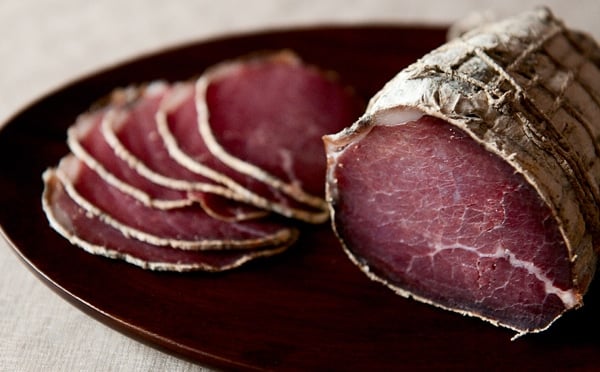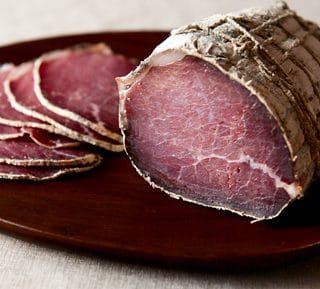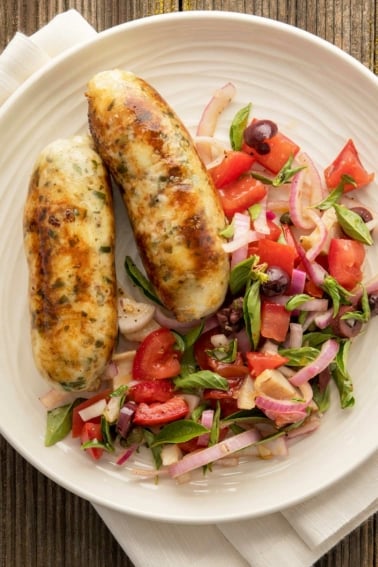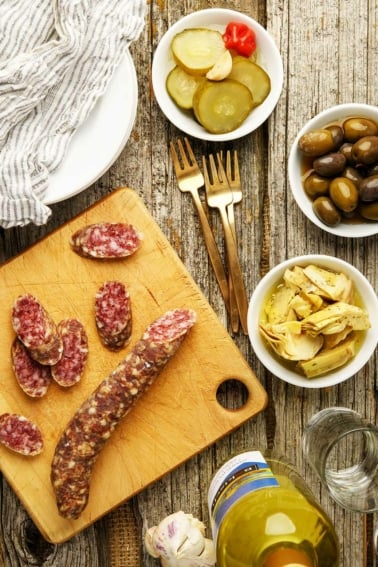As an Amazon Associate I earn from qualifying purchases.

One of the best ways to get into curing meats is to do a bresaola, air-cured loin of some sort of red meat. Thinly sliced, it is a magnificent piece of charcuterie, deep red, light on the tongue and very meaty. Bresaola is the easiest charcuterie project you can make, other than bacon. It’s is nothing more than lean meat, salted and air-dried.
It is a Northern Italian creation, but many, many other cultures have something similar: The Spaniards have their lomo, the Armenians have pastirma, the Greeks call it apokti and the Swiss bindenfleisch. In some cases the meat is beef, others pork, and in a few instances large wild game is used.
It is always a solid muscle, usually the eye round, which is a sort of false tenderloin that hides within the back legs of four-footed creatures. But a length of loin or backstrap works just as well.
For these photos, I chose to go with bison eye round. No, I did not go out and shoot a buffalo and not tell you about it. I actually ordered it from Whole Foods. Beef eye round works well, and although I could have used some venison backstrap, I did not want to part with it for charcuterie. I don’t kill many deer a year, so backstrap is precious.

In a nutshell, all you need to do is salt the meat down and then hang it in a cool place until it is as firm as you want it. An Italian bresaola is coated in spices, however. So are pastirma and apokti. The only hard part of it all is keeping humidity even and high for the weeks or months you’re hanging this puppy.
It is essential to keep the humidity above 70 percent. I start mine at 85 to 90 percent for a few days, then ratchet it down 5 percent a week until it gets to 70 percent, then I hold it there for a month. After that I ratchet it down to 60 percent, where it can stay indefinitely.
If your humidity goes too low, you risk what’s called “case hardening,” which is when the outside dries and hardens faster than the inside. This can be anything from unsightly to dangerous. In the case of the batch in the photos, it was pretty mild: The outside of the meat is a little darker than the center, but it is all cured and nice.
In bad cases, the outside can harden so much the inside can no longer lose its moisture — and then the meat rots from the center. Tragedy.
To make a curing chamber, you will need an old fridge (look on Craigslist or something), a temperature regulator, a small humidifer, and a little fan to keep the air moving. You’ll also need “s” hooks to hang the bresaola up. Here is a good primer on equipment you will need to cure meat.
I cured my bresaola for three months. At the end of that time, the outside was covered in white mold, with a little green here and there. It had a funky-yet-sweet aroma and tasted superb. The long hang time is the difference. You can make a decent bresaola in as little as a month, but the longer you can take it, the mellower the salt and spices will become, and the funkier it will get; and I mean that in a good way.
How do you eat it? I slice it as thin as I can (a meat slicer is best if you have access to one) and eat it as-is. But you can drizzle some olive oil and lemon juice over it, throw some arugula on top and grind a little black pepper over it all. That’s how the Italians do it. I rarely do anything more than stand there and eat it at the counter.
Bresaola
Ingredients
- A 4-pound piece of eye round or loin trimmed of fat and sinew
- 34 grams of kosher salt, about 2 tablespoons
- 40 grams of sugar, about 3 tablespoons
- 5 grams of Instacure No. 2, about a heaping teaspoon
- 10 grams of maple sugar, about tablespoon (optional)
- 15 grams of ground juniper, about 2 tablespoons
- 3 grams of dried marjoram, about 1 tablespoon
- 5 grams of dried sage, about 2 tablespoons
- 25 grams of ground black pepper, about 2 tablespoons
Instructions
- Make sure your meat has most of the fat and all of the sinew removed. Bresaola is supposed to be lean. Trim the ends to make a nice cylinder.
- Mix all the spices together and massage them into the meat so it is well coated. Save any excess spices.
- Put the meat and the excess spices into a plastic or other non-reactive container and put in the refrigerator. Cure this for 12 days, turning the meat over once a day. Pour off any liquid that accumulates, and redistribute the spices as needed. If the meat is 2 inches wide or less, cure for only 6 to 10 days. The meat is ready when it feels firm.
- Rinse off the spices under cold water and pat dry with paper towels. It's OK if some spices stay stuck to the meat. You just don't want them all there for a bresaola. In pastirma and apokti, new ground spices are added at this step, so if you want to, you can add another round of spices -- just leave out the salt, curing salt and sugar.
- Truss the meat, or fit into a sausage netting; you can buy these online through Butcher & Packer. Hang in your curing chamber.
- Set your humidity so it is between 85 and 90 percent for a week. Set your temperature in the curing chamber between 50°F and 55°F. Check your humidifier every couple days to make sure it has water in it. Ratchet the humidity down 5 percent each week until you get to 70 percent. Leave it there. It's OK if it jumps higher from time to time, but under no circumstances should you let the humidity get lower than 50 percent. Your bresaola can survive a few of these humidity "accidents," but be vigilant.
- Monitor mold. You actually want a layer of white mold on the bresaola: It protects the meat from nastier molds, and helps the meat to dry evenly. You can inoculate your bresaola with a special mold culture you can buy through The Sausage Maker. Remember: White mold is good. Green mold is not the end of the world, but wipe it away periodically with vinegar. Black mold is bad. If you get a serious growth of black mold, toss the meat. Vinegar is your friend here. Keep tabs on the bresaola and molds will not get out of hand.
- After at least a month and as much as 6 months, when your bresaola is firm enough, take it out of the chamber and into the fridge. It will last there indefinitely. You can also keep it in your chamber, or you can seal and freeze it.
Notes
Nutrition information is automatically calculated, so should only be used as an approximation.





First off, don’t shoot me for not making traditional bresaola. That being said, the inspiration for my creation was derived from this recipe.
I had a solid leftover piece of brisket I wanted to try something new with. Split it into two pieces of just over a pound each. Cured the first with a Montreal Steak seasoning profile and the second with ground caraway and anise seeds (strange, maybe… delicious, definitely).
Meat was rubbed, bagged and cured for 9 days in the fridge. Then enough Cab Sauv was added to the bags to cover the meat. I mixed and flipped them every few hours and then let it sit overnight in the fridge. Next day I did a cool-ish (100-150F) smoke for 90 min with oak lump charcoal and barkless birch from my property. Just enough so it came out looking like a rare prime rib roast. This imparted an amazingly smoky flavor to the meat and allowed me to just do a 10 day dry in the fridge.
Both were simply amazing cut thinly as charcuterie. Again, not trying to pass this off as bresaola, but it sure was an experiment that turned out to be delicious
Hank,
Your salt is 2% and Cure #2 is 0.25% based on this recipe with 4lbs of meat. I ruined several venison whole muscles using these numbers, they just oozed and rotted in my cabinet at 55F and 75% RH. Marianski uses 2.8% salt and 0.6% #2, over twice yours. What’s the correct numbers for a dry cure?
Thanks,
Ted
Ted: My numbers work fine. I and hundreds of others have used this recipe successfully. I do hang cooler though, about 50F with higher humidity. If you prefer Marianski, use his numbers. He is a skilled meat curer, too.
Hank,
I backed off the temp to 50F, made all the difference.
Many thanks,
Ted
Deat TD
4 lbs = 1,8 kg meat. 1800g x 0,25% = 4500 mg, this contains 6,25% sodium nitrite -> 280 mg, 280 mg in 1.8 kg is 156 mg/kg which in 156 ppm (ppm is mg/kilogram).
Recommended nitrite level which makes the meat safe in EU is 120 ppm, nitrite levels decrease quite rapidly during the curing process. This 120 ppm level in my starting point with capocollos, bresiolas, sausages.
My cure cabin (modified wine cabin) keeps temp at 55F (13C), and RH% 75. Cured meats I have sprayed with Penicilium nalgiavense suspension
But you will always work with your own risk.
once the meat is finished, can I vacume seal it in mylar bags, perhaps with an oxygen absorber and store at room temperature indefinitely? or for at least a few years.
Garland: I don’t think you can store this at room temperature very long. At least, I am not in a position to offer you advice on this. I always keep mine in the fridge.
Have you tried the UMAI dry age bags. I have dry aged entire ribeye roasts and made bresaola and they worked fantastic.
For those of us that don’t have a chamber.
Dave: I am not a fan of UMAI bags, sorry. I don’t use them.
Hi Hank,
Can this type of curing/drying be achieved with the use of small venison loin cuttings? I’ve got like 5 pounds of small trimmings from portioning the loins at the restaurant 😉
I guess if possible this would turn out to be some type of salami then without the fat? Thanks in advance!
Hi, thanks for the information. I’m part Sicilian, so I think it sings to my soul.
Is the sugar necessary? I need to make a sugar free recipe. Also, I’m leaving for a 9 day motorcycle trip in 4 weeks. Is there any kind of cured/preserved meat I can make before then? If not, I’ll resort to going with all smoked/dehydrated.
Thank you!
John: Nope, you can skip the sugar. With only 4 weeks, the best you could do would be a skinny salami in a hog casing, like a landjager.
Hi Hank. I am trying my first batch of Lonzino. I have a Temp/Humid regulated fridge that I made from a 2.7 cu ft mini fridge. I am sure that it will work out fine. I would like to try this recipe you have for Bresaola. Is there anything that will be much different that the Lonzino recipe that I am using, which is very similar to your recipe? And will the taste be similar or different than the Lonzino?
Max: They are very similar. Taste is different because you use pork for one, beef or other red meat from the other.
Thank you for the comprehensive explanation on How to cure Bresaola. I’d like to make a tiny contribution; we had plenty of good food originated from Armenians or Greeks in Turkey however Pastirma is not one of them. It is purely Turkish and a signature cured meat originated from Kastamonu and Kayseri regions of Turkey (Even those two regions have an eternal clash on the possession of Pastirma) and had the geographical indications by Turkey in EU. As many others like Baklava, Adana kebap or doner. And trust me it is not pretty much the same stuff.!.. You should pay a visit to Turkey sometime and experience the very unique Turkish Culinary heritage.
Ali: I can assure you that the Armenians have their own version that is as good as the Turkish one. I’ve eaten it for years. And so do the Greeks. That region is very competitive in everything, including food, but if you take a 30,000 foot look at it, they are all very similar, with minor differences. It is minor to me, and you are free to disagree.
Hi Hank,
Very informative and helpful page. Just a quick info of you don’t mind. Having lived there for a long while pastirma is actually Turkish and the name literally means pressed. Not meaning to start a culinary war between the countries but thought it’s relevant.
Gene: Every country in that area has a version of it: Greeks, Turks, Armenians. It’s all pretty much the same stuff.
Hi Hank,
I didn’t get an early enough start, and I’m coming up on a time crunch for a dinner party just under 6 weeks from today. If I use a smaller piece, say a venison eye of round from a small deer, would that go through the drying process faster? or would that result in more meat loss or quality issues, due to the cigar shape/thin ends? Or is 6 weeks enough time for a relatively small sirloin or top or bottom round to cure and dry? (I would guess 1.5 – 2 .25 lbs.) Thanks in advance!
Mike
Mike: You can get it done in 6 weeks with a smaller piece. Square off the ends, though, so it cures evenly.
Am I missing the links you reference for what you use for your curing chamber?
bresaola with previously frozen meat?
Scabbz: Yes. Works fine.
I am about to start this project and it is winter in South Dakota. Do I need to keep the fridge in the house or can I leave it in the garage where temps can sometimes dip below freezing? I am worried about the inside staying at 50-55 degrees.
Matt: It cannot freeze, but you are OK with it being colder than 50F. My worry for you is humidity. Doesn’t it get really dry in your winters up there?
Been following hank for a long time and finally got off my assignment and built a curing chamber from a full size upright freezer. Just started this in the chamber a few days ago, can’t wait for the day oy reckoning!
Just started my first batch this last week. Worst part is the waiting!
Just finding your site and it is great!! I never saw the link for the homemade curing chamber, though. Looking forward to reading more of your stuff! Thanks!
How about curing the entire time in a wine cellar at 55 degrees and 70 percent RH?
Matt: 70% humidity is too low to start out. You will get some case hardening then, which is no bueno.
Hey,
I’m working on building a fully automated curing/fermentation chamber. In the meantime I was given a doe. I was looking to get the chamber up and running while I work on the code, but can’t find the components (links?) you allude to in the blog. Can you please re-post?
Also, when I butchered the doe I left one of the hams intact to cure as a prosciutto but froze it since I haven’t finished my chamber yet. Anything wrong with curing previously frozen meat?
No worries, I just got it to the perfect humidity, starting the curing outside the water and the nitrites, the only difference is that I tied butcher knots, ‘ll comment later
Hi, it’s me again, Agostinho, I’m having problems with the humidity, I don’t have a humidifier but the humidity here is high, but i’m not totally sure how high, i bought a digital hygrometer but it’s bad inside the fridge, doesn’t measure right (i think) but almost everytime is above 80%, but in case is lower, should i try with a thinner piece? it would be better so It doesn’t get affected by case hardening? thanks and sorry, when i get results i’ll post it
Hi, i’m looking to start at curing, i’m starting to build the chamber but it would be a lot of time (i’ll explain later), there’s so much trouble if the temperature is lower? just the temperature, the humidity at the ranges posted here, but it’s pretty hard to have the temperature at those rates, it could be around 40 to 50? cause i’ll make it at a place that half the day is at the perfect temperature (50 to 60) but at night i could only leave it in a fridge (that doesn’t freeze) at around 40 to 50, that would be much trouble? should I be changing between the 50 to 60 and the 40 to 50? or just leave it at 40 to 50? I would be half day and half day at each temperatura, another thing i didn’t get, you mean 2 inches for startes but from the center or all the way 2 inches? thanks, have a good day, so excited to follow your recipes.
Agostinho: Yep, you’ll be fine at those temperatures.
I’m in the process of hanging my beef and also venison bresaola. It has developed a fairly uniform white mold over most of the surface. However there are several spots the size of a quarter of fuzzy gray mold.
Any thoughts?
Steven: I’d leave it, but watch it. Wipe off with distilled water if it gets too gnarly.